Financial Reporting Analysis: Tesco, Financial Statements, and IFRS
VerifiedAdded on 2021/02/19
|16
|4262
|68
Report
AI Summary
This report provides a comprehensive analysis of financial reporting, exploring its context, purpose, and the regulatory framework, including IAS and IFRS. It examines the qualitative characteristics of financial information and identifies the main stakeholders of an organization, detailing how they benefit from financial reporting. The report further discusses the value of financial reporting in meeting organizational objectives and driving growth. It presents the main financial statements, including the statement of profit or loss, statement of changes in equity, and balance sheet, and explains how to interpret and communicate financial performance. The differences between IAS and IFRS are highlighted, along with the benefits of IFRS and varying degrees of compliance. The report uses Tesco as a case study to illustrate these concepts, providing practical examples and insights into financial reporting practices within a FTSE company.
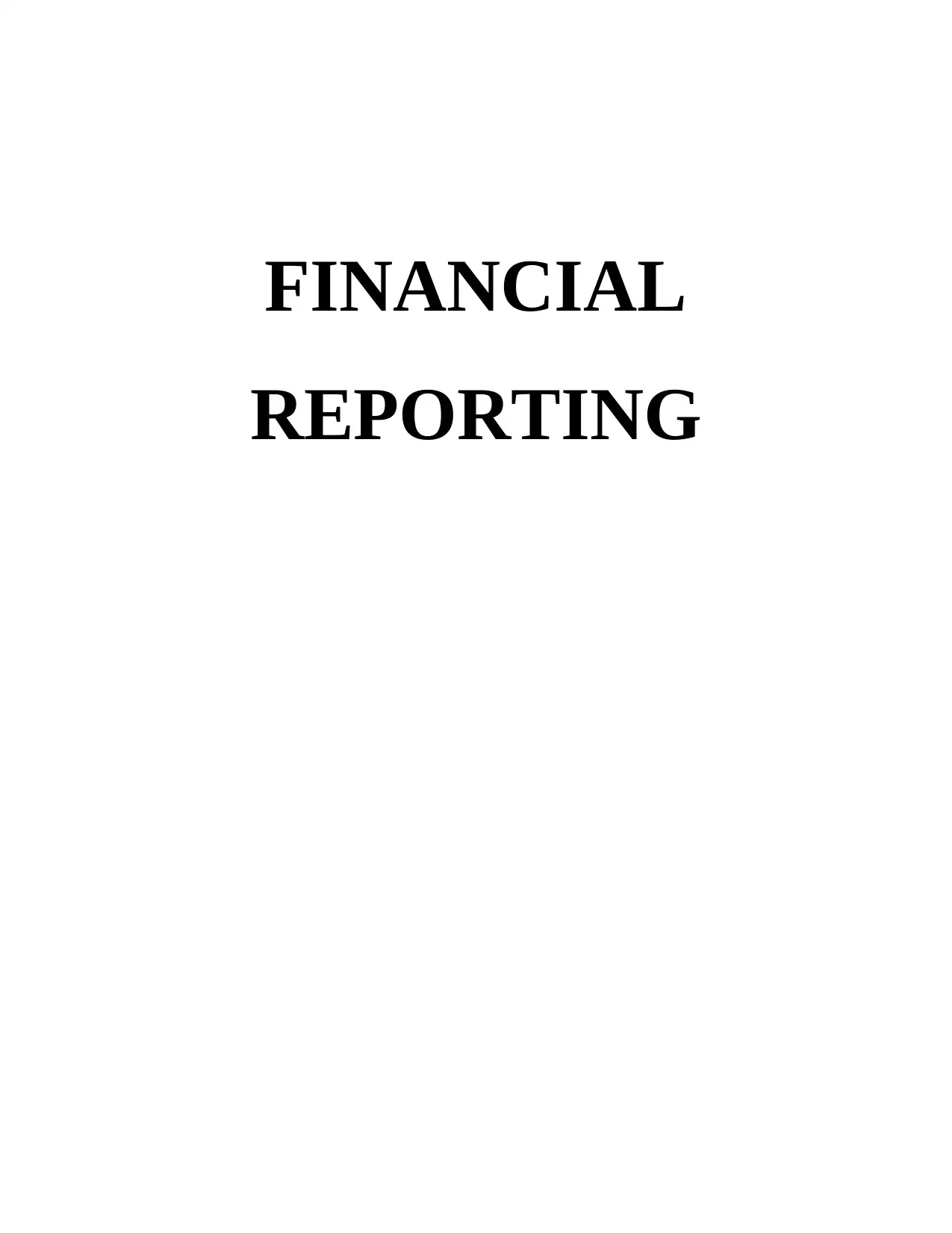
FINANCIAL
REPORTING
REPORTING
Paraphrase This Document
Need a fresh take? Get an instant paraphrase of this document with our AI Paraphraser
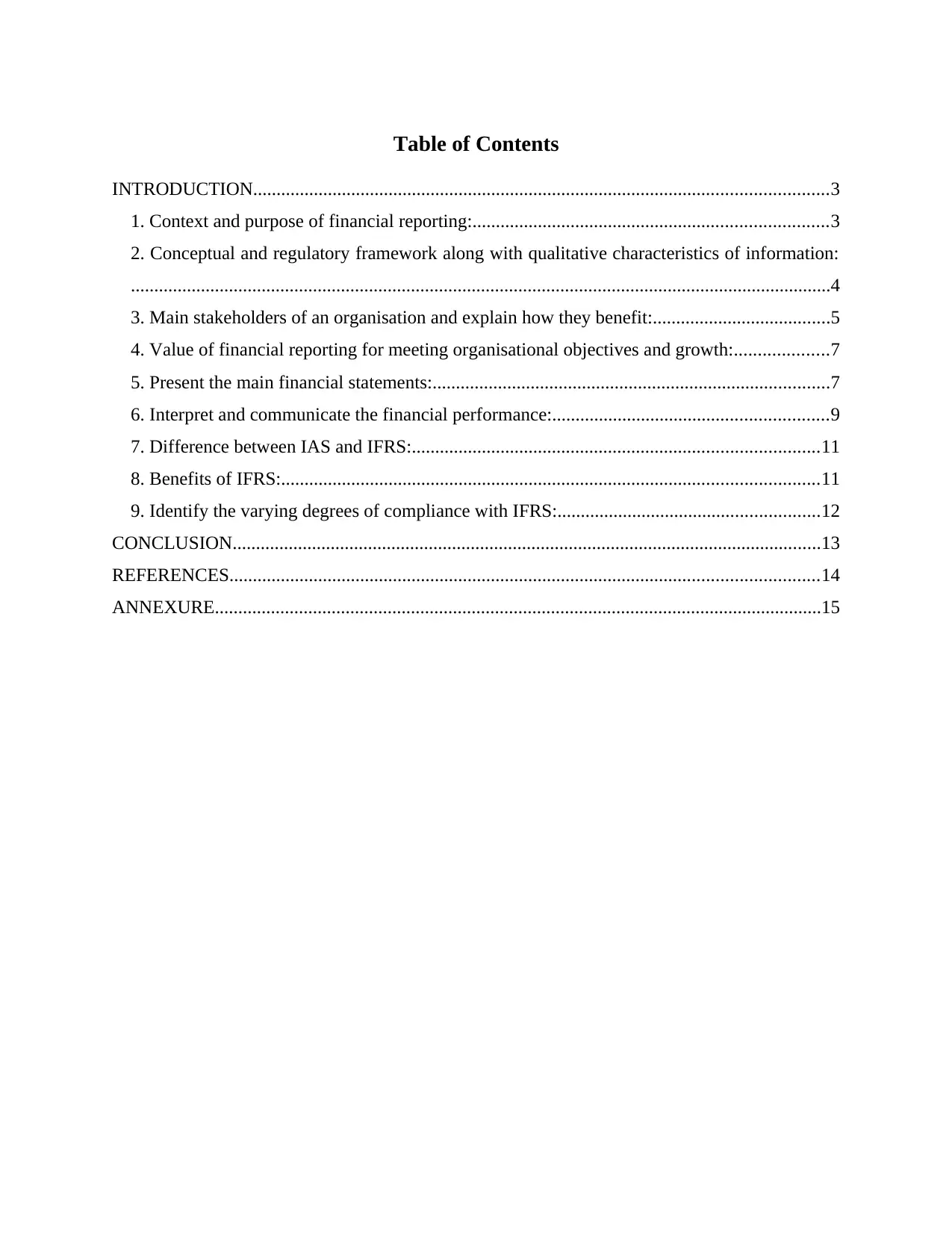
Table of Contents
INTRODUCTION...........................................................................................................................3
1. Context and purpose of financial reporting:............................................................................3
2. Conceptual and regulatory framework along with qualitative characteristics of information:
......................................................................................................................................................4
3. Main stakeholders of an organisation and explain how they benefit:......................................5
4. Value of financial reporting for meeting organisational objectives and growth:....................7
5. Present the main financial statements:.....................................................................................7
6. Interpret and communicate the financial performance:...........................................................9
7. Difference between IAS and IFRS:.......................................................................................11
8. Benefits of IFRS:...................................................................................................................11
9. Identify the varying degrees of compliance with IFRS:........................................................12
CONCLUSION..............................................................................................................................13
REFERENCES..............................................................................................................................14
ANNEXURE..................................................................................................................................15
INTRODUCTION...........................................................................................................................3
1. Context and purpose of financial reporting:............................................................................3
2. Conceptual and regulatory framework along with qualitative characteristics of information:
......................................................................................................................................................4
3. Main stakeholders of an organisation and explain how they benefit:......................................5
4. Value of financial reporting for meeting organisational objectives and growth:....................7
5. Present the main financial statements:.....................................................................................7
6. Interpret and communicate the financial performance:...........................................................9
7. Difference between IAS and IFRS:.......................................................................................11
8. Benefits of IFRS:...................................................................................................................11
9. Identify the varying degrees of compliance with IFRS:........................................................12
CONCLUSION..............................................................................................................................13
REFERENCES..............................................................................................................................14
ANNEXURE..................................................................................................................................15

INTRODUCTION
Financial reporting is combined set of activities and practices which are dedicated
towards prompt presentation and reporting of monetary events and other business transaction in
systematic and regularised manner. Practices involved in financial reporting ensures proper and
effective compliance of relevant accounting policies, procedures and other statutory
requirements. Financial reporting requires disclosing fiscal data over a defined time period to the
multiple stakeholders on organisation's fiscal efficiencies and performance position. These
stakeholders involve–shareholders, investors, government bodies, banks, debt providers. The
purpose of study report is to enhance comprehension of financial reporting as well as its
significance to enterprises (Billings and Lewis‐Western, 2016). Its aim is to continue providing
information and inputs to a company's management, which are used for monitoring, evaluation,
performance metrics and decision-making purposes. As a junior auditor of a large accounting
and consultancy enterprise, Smith & Williamson, a FTSE company is selected to better explain
all the above-mentioned terms and that company is Tesco.
The study evaluates main context and aim of financial reporting, major qualitative
features which required to generate reliable financial, corporation's stakeholders and importance
of financial information and role of financial-reporting. Moreover, it contains practical sum
related to preparation of IAS based financial statement. It also contains key departure between
IFRS and IAS and degree of compliances related to them.
1. Context and purpose of financial reporting:
In commercial environment, financial reporting has now been known to play a crucial
role in the development and establishment of the global financial system. The principal purpose
is to ensure that users have data and facts that is efficient and valuable so that significant choices
are made in order to improve enterprise effectiveness. Managers need an annual report
summarizing the effectiveness and the condition of their corporation to assess how often they
have achieved their business throughout an accounting period. Financial reporting is also
concerned with adoption of regulatory and compliance framework-based structure (Cohen and
Karatzimas, 2015). Reporting in corporations is done by accountants and management personnel
on periodical basis like annual, quarter, monthly etc. For both internal and external purposes
financial reporting is used by corporations which ultimately supports decision-making. It is the
Financial reporting is combined set of activities and practices which are dedicated
towards prompt presentation and reporting of monetary events and other business transaction in
systematic and regularised manner. Practices involved in financial reporting ensures proper and
effective compliance of relevant accounting policies, procedures and other statutory
requirements. Financial reporting requires disclosing fiscal data over a defined time period to the
multiple stakeholders on organisation's fiscal efficiencies and performance position. These
stakeholders involve–shareholders, investors, government bodies, banks, debt providers. The
purpose of study report is to enhance comprehension of financial reporting as well as its
significance to enterprises (Billings and Lewis‐Western, 2016). Its aim is to continue providing
information and inputs to a company's management, which are used for monitoring, evaluation,
performance metrics and decision-making purposes. As a junior auditor of a large accounting
and consultancy enterprise, Smith & Williamson, a FTSE company is selected to better explain
all the above-mentioned terms and that company is Tesco.
The study evaluates main context and aim of financial reporting, major qualitative
features which required to generate reliable financial, corporation's stakeholders and importance
of financial information and role of financial-reporting. Moreover, it contains practical sum
related to preparation of IAS based financial statement. It also contains key departure between
IFRS and IAS and degree of compliances related to them.
1. Context and purpose of financial reporting:
In commercial environment, financial reporting has now been known to play a crucial
role in the development and establishment of the global financial system. The principal purpose
is to ensure that users have data and facts that is efficient and valuable so that significant choices
are made in order to improve enterprise effectiveness. Managers need an annual report
summarizing the effectiveness and the condition of their corporation to assess how often they
have achieved their business throughout an accounting period. Financial reporting is also
concerned with adoption of regulatory and compliance framework-based structure (Cohen and
Karatzimas, 2015). Reporting in corporations is done by accountants and management personnel
on periodical basis like annual, quarter, monthly etc. For both internal and external purposes
financial reporting is used by corporations which ultimately supports decision-making. It is the
⊘ This is a preview!⊘
Do you want full access?
Subscribe today to unlock all pages.

Trusted by 1+ million students worldwide

presentation of corporation's significant monetary information & certain operations to different
stakeholders to support them at every stage in period get core performance information about
incorporation. In this context following are core purposes linked to financial reporting, as
discussed below:
Financial reporting's principal aim is to avoid conflicts related to accounting procedures
adopted by ensuring proper compliance with accounting standards like IAS, IFRS etc.
Main purpose behind adoption of Financial reporting is that it facilitates effective linking
of organisational objectives and decision-making processes with company's accounting
framework dedicated to present and prepare fiscal reports.
It facilitates effective and prompt decision making for investors by providing key fiscal
reports and statements.
It aims to remove any misleading information. which can be reported in financial
statements of corporation (Dichev, 2017).
It supports management of major productive activities of company by providing useful
and quick information.
Provide relevant information through financial statements based on which banks and
financial institutions provides loans and credit-related facilities.
Financial reports generated under process of financial reporting build trust in users of
corporation's financial reports.
2. Conceptual and regulatory framework along with qualitative characteristics of information:
Conceptual and Regulatory framework: Regulatory framework is a mechanism which
assure effective compliance of rules and regulations issued by regulatory authorities. It aims to
assure that individuals obtain a reasonable level of information to make massive decisions based
on their concern in reporting organization.
While a conceptual framework relates to coherent structure of interlinked principles and
objectives (Durnev and Magnan, 2017). A framework that sets out the essence, feature, and
boundaries of business's financial accounting as well as reporting. Conceptual frameworks may
extend to plenty of areas, but where particularly relating to financial reporting is concerned, a
conceptual framework could be viewed as a declaration of GAAP that constitute a reference
point for evaluating current practices and developing fresh ones. Conceptual Framework's aim is
to assist in preparation of financial statements in developing accounting-policies for events or
stakeholders to support them at every stage in period get core performance information about
incorporation. In this context following are core purposes linked to financial reporting, as
discussed below:
Financial reporting's principal aim is to avoid conflicts related to accounting procedures
adopted by ensuring proper compliance with accounting standards like IAS, IFRS etc.
Main purpose behind adoption of Financial reporting is that it facilitates effective linking
of organisational objectives and decision-making processes with company's accounting
framework dedicated to present and prepare fiscal reports.
It facilitates effective and prompt decision making for investors by providing key fiscal
reports and statements.
It aims to remove any misleading information. which can be reported in financial
statements of corporation (Dichev, 2017).
It supports management of major productive activities of company by providing useful
and quick information.
Provide relevant information through financial statements based on which banks and
financial institutions provides loans and credit-related facilities.
Financial reports generated under process of financial reporting build trust in users of
corporation's financial reports.
2. Conceptual and regulatory framework along with qualitative characteristics of information:
Conceptual and Regulatory framework: Regulatory framework is a mechanism which
assure effective compliance of rules and regulations issued by regulatory authorities. It aims to
assure that individuals obtain a reasonable level of information to make massive decisions based
on their concern in reporting organization.
While a conceptual framework relates to coherent structure of interlinked principles and
objectives (Durnev and Magnan, 2017). A framework that sets out the essence, feature, and
boundaries of business's financial accounting as well as reporting. Conceptual frameworks may
extend to plenty of areas, but where particularly relating to financial reporting is concerned, a
conceptual framework could be viewed as a declaration of GAAP that constitute a reference
point for evaluating current practices and developing fresh ones. Conceptual Framework's aim is
to assist in preparation of financial statements in developing accounting-policies for events or
Paraphrase This Document
Need a fresh take? Get an instant paraphrase of this document with our AI Paraphraser
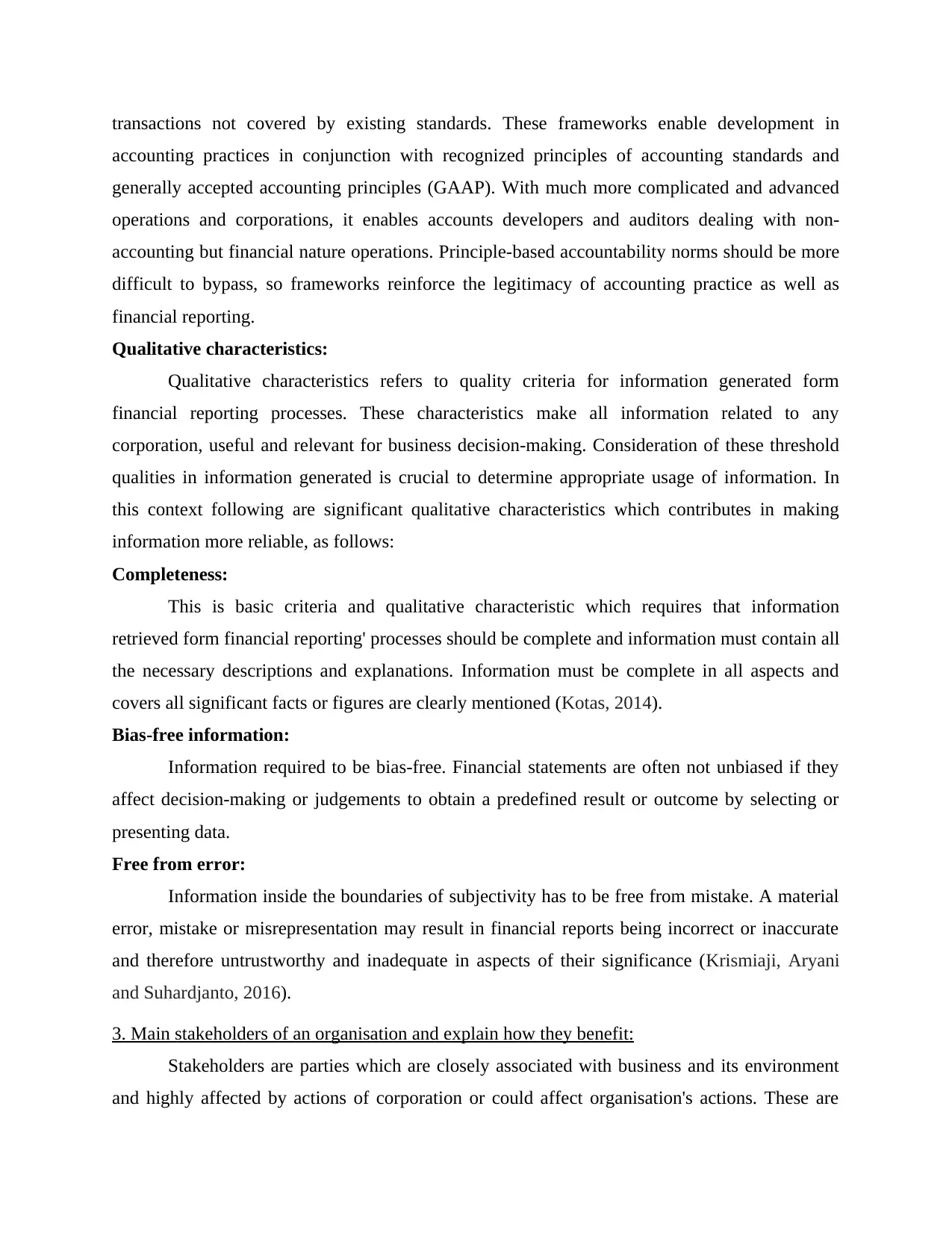
transactions not covered by existing standards. These frameworks enable development in
accounting practices in conjunction with recognized principles of accounting standards and
generally accepted accounting principles (GAAP). With much more complicated and advanced
operations and corporations, it enables accounts developers and auditors dealing with non-
accounting but financial nature operations. Principle-based accountability norms should be more
difficult to bypass, so frameworks reinforce the legitimacy of accounting practice as well as
financial reporting.
Qualitative characteristics:
Qualitative characteristics refers to quality criteria for information generated form
financial reporting processes. These characteristics make all information related to any
corporation, useful and relevant for business decision-making. Consideration of these threshold
qualities in information generated is crucial to determine appropriate usage of information. In
this context following are significant qualitative characteristics which contributes in making
information more reliable, as follows:
Completeness:
This is basic criteria and qualitative characteristic which requires that information
retrieved form financial reporting' processes should be complete and information must contain all
the necessary descriptions and explanations. Information must be complete in all aspects and
covers all significant facts or figures are clearly mentioned (Kotas, 2014).
Bias-free information:
Information required to be bias-free. Financial statements are often not unbiased if they
affect decision-making or judgements to obtain a predefined result or outcome by selecting or
presenting data.
Free from error:
Information inside the boundaries of subjectivity has to be free from mistake. A material
error, mistake or misrepresentation may result in financial reports being incorrect or inaccurate
and therefore untrustworthy and inadequate in aspects of their significance (Krismiaji, Aryani
and Suhardjanto, 2016).
3. Main stakeholders of an organisation and explain how they benefit:
Stakeholders are parties which are closely associated with business and its environment
and highly affected by actions of corporation or could affect organisation's actions. These are
accounting practices in conjunction with recognized principles of accounting standards and
generally accepted accounting principles (GAAP). With much more complicated and advanced
operations and corporations, it enables accounts developers and auditors dealing with non-
accounting but financial nature operations. Principle-based accountability norms should be more
difficult to bypass, so frameworks reinforce the legitimacy of accounting practice as well as
financial reporting.
Qualitative characteristics:
Qualitative characteristics refers to quality criteria for information generated form
financial reporting processes. These characteristics make all information related to any
corporation, useful and relevant for business decision-making. Consideration of these threshold
qualities in information generated is crucial to determine appropriate usage of information. In
this context following are significant qualitative characteristics which contributes in making
information more reliable, as follows:
Completeness:
This is basic criteria and qualitative characteristic which requires that information
retrieved form financial reporting' processes should be complete and information must contain all
the necessary descriptions and explanations. Information must be complete in all aspects and
covers all significant facts or figures are clearly mentioned (Kotas, 2014).
Bias-free information:
Information required to be bias-free. Financial statements are often not unbiased if they
affect decision-making or judgements to obtain a predefined result or outcome by selecting or
presenting data.
Free from error:
Information inside the boundaries of subjectivity has to be free from mistake. A material
error, mistake or misrepresentation may result in financial reports being incorrect or inaccurate
and therefore untrustworthy and inadequate in aspects of their significance (Krismiaji, Aryani
and Suhardjanto, 2016).
3. Main stakeholders of an organisation and explain how they benefit:
Stakeholders are parties which are closely associated with business and its environment
and highly affected by actions of corporation or could affect organisation's actions. These are

interested or concerned in corporation's fiscal results and outcomes in direct or indirect manner.
Corporations are also benefited or influenced by actions and decisions of stakeholders.
Identification of current actions and potential steps are necessary to minimise the negative
impact of such actions and steps. Stakeholder in organisational context are categorised by
internal and external.
Internal Stakeholders are crucial part of business enterprise, these mainly includes
employees, managing officials, directors etc. Here is discussion on internal stakeholders and how
they get benefited from financial information, as follows:
Employees: These are not only effective resources of a corporation but also crucial
internal stakeholders which works for business's objectives and targets. They are get benefited by
financial information as they want to be assured about corporation's future and current growth to
ensure their future in respective organisation (Lail, MacGregor and Stuebs, 2017).
Directors: Directors are also internal stakeholders who always worried about
corporation's performance and growth in industry. Directors majorly use financial information to
take appropriate and momentous corporate decisions and competitive strategies with aim to
achieve targeted performance and results.
External stakeholders are not integral part of corporation but affects functioning and
performance. Major external stakeholders are suppliers, regulatory bodies, government,
customers etc. Following is discussion on main external stakeholders and in which way they are
get benefited from financial information, as follows:
Government and regulatory authority: These are top influencers and external
stakeholders as every organisation is required to follow guidelines and instructions issued by
them. They apply financial information to assess tax liabilities of corporation as this is the main
income source of government which is beneficial for government to increase tax revenue.
Financial information also advantageous for government also using to establish control by
ensuring that all rules and compliances are followed or not (Mio, 2016).
Customer: They are most considerable external stakeholders who are responsible for
corporation's sales. Financial information is beneficial for company's customers to determines its
brand value and popularity of products.
Corporations are also benefited or influenced by actions and decisions of stakeholders.
Identification of current actions and potential steps are necessary to minimise the negative
impact of such actions and steps. Stakeholder in organisational context are categorised by
internal and external.
Internal Stakeholders are crucial part of business enterprise, these mainly includes
employees, managing officials, directors etc. Here is discussion on internal stakeholders and how
they get benefited from financial information, as follows:
Employees: These are not only effective resources of a corporation but also crucial
internal stakeholders which works for business's objectives and targets. They are get benefited by
financial information as they want to be assured about corporation's future and current growth to
ensure their future in respective organisation (Lail, MacGregor and Stuebs, 2017).
Directors: Directors are also internal stakeholders who always worried about
corporation's performance and growth in industry. Directors majorly use financial information to
take appropriate and momentous corporate decisions and competitive strategies with aim to
achieve targeted performance and results.
External stakeholders are not integral part of corporation but affects functioning and
performance. Major external stakeholders are suppliers, regulatory bodies, government,
customers etc. Following is discussion on main external stakeholders and in which way they are
get benefited from financial information, as follows:
Government and regulatory authority: These are top influencers and external
stakeholders as every organisation is required to follow guidelines and instructions issued by
them. They apply financial information to assess tax liabilities of corporation as this is the main
income source of government which is beneficial for government to increase tax revenue.
Financial information also advantageous for government also using to establish control by
ensuring that all rules and compliances are followed or not (Mio, 2016).
Customer: They are most considerable external stakeholders who are responsible for
corporation's sales. Financial information is beneficial for company's customers to determines its
brand value and popularity of products.
⊘ This is a preview!⊘
Do you want full access?
Subscribe today to unlock all pages.

Trusted by 1+ million students worldwide
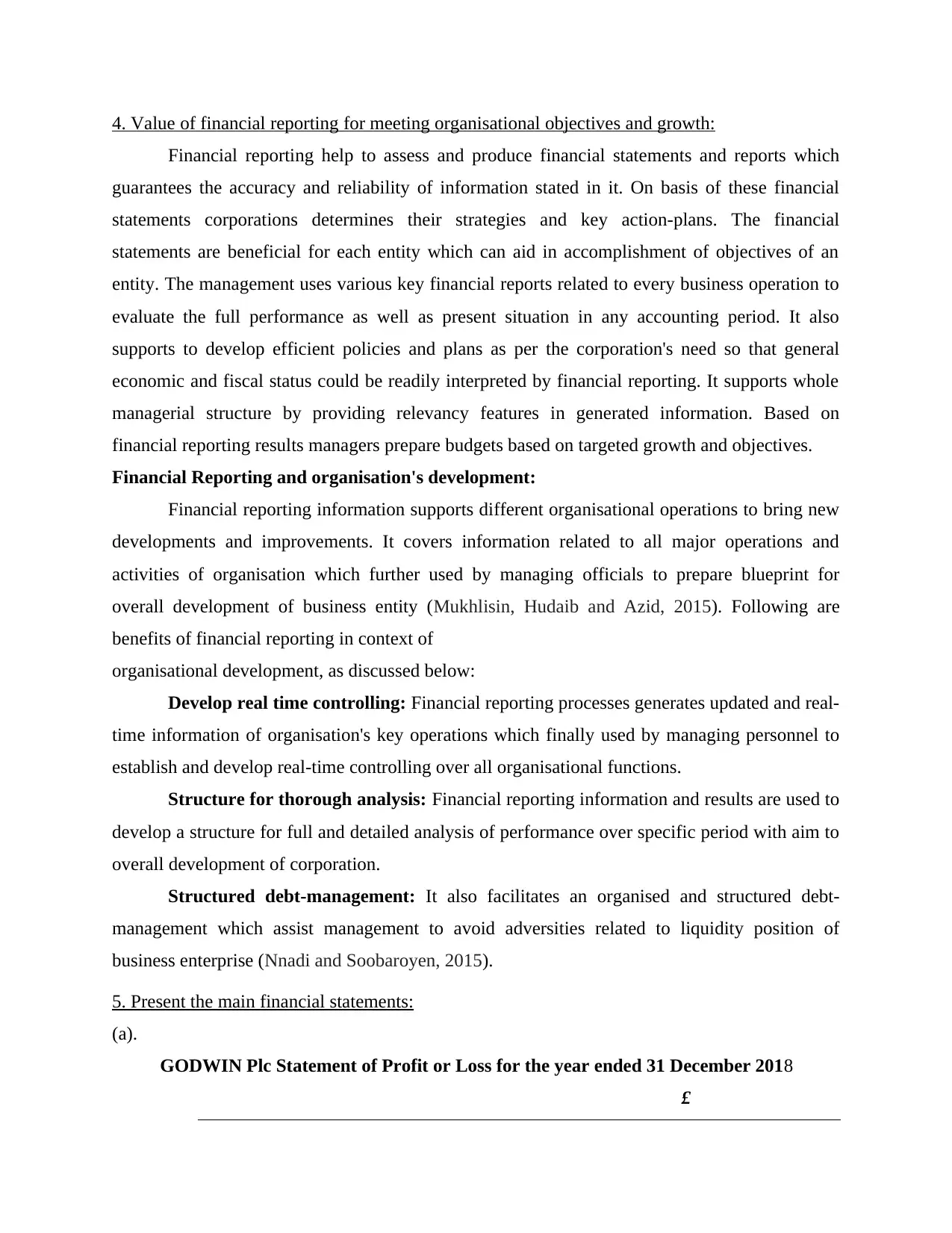
4. Value of financial reporting for meeting organisational objectives and growth:
Financial reporting help to assess and produce financial statements and reports which
guarantees the accuracy and reliability of information stated in it. On basis of these financial
statements corporations determines their strategies and key action-plans. The financial
statements are beneficial for each entity which can aid in accomplishment of objectives of an
entity. The management uses various key financial reports related to every business operation to
evaluate the full performance as well as present situation in any accounting period. It also
supports to develop efficient policies and plans as per the corporation's need so that general
economic and fiscal status could be readily interpreted by financial reporting. It supports whole
managerial structure by providing relevancy features in generated information. Based on
financial reporting results managers prepare budgets based on targeted growth and objectives.
Financial Reporting and organisation's development:
Financial reporting information supports different organisational operations to bring new
developments and improvements. It covers information related to all major operations and
activities of organisation which further used by managing officials to prepare blueprint for
overall development of business entity (Mukhlisin, Hudaib and Azid, 2015). Following are
benefits of financial reporting in context of
organisational development, as discussed below:
Develop real time controlling: Financial reporting processes generates updated and real-
time information of organisation's key operations which finally used by managing personnel to
establish and develop real-time controlling over all organisational functions.
Structure for thorough analysis: Financial reporting information and results are used to
develop a structure for full and detailed analysis of performance over specific period with aim to
overall development of corporation.
Structured debt-management: It also facilitates an organised and structured debt-
management which assist management to avoid adversities related to liquidity position of
business enterprise (Nnadi and Soobaroyen, 2015).
5. Present the main financial statements:
(a).
GODWIN Plc Statement of Profit or Loss for the year ended 31 December 2018
£
Financial reporting help to assess and produce financial statements and reports which
guarantees the accuracy and reliability of information stated in it. On basis of these financial
statements corporations determines their strategies and key action-plans. The financial
statements are beneficial for each entity which can aid in accomplishment of objectives of an
entity. The management uses various key financial reports related to every business operation to
evaluate the full performance as well as present situation in any accounting period. It also
supports to develop efficient policies and plans as per the corporation's need so that general
economic and fiscal status could be readily interpreted by financial reporting. It supports whole
managerial structure by providing relevancy features in generated information. Based on
financial reporting results managers prepare budgets based on targeted growth and objectives.
Financial Reporting and organisation's development:
Financial reporting information supports different organisational operations to bring new
developments and improvements. It covers information related to all major operations and
activities of organisation which further used by managing officials to prepare blueprint for
overall development of business entity (Mukhlisin, Hudaib and Azid, 2015). Following are
benefits of financial reporting in context of
organisational development, as discussed below:
Develop real time controlling: Financial reporting processes generates updated and real-
time information of organisation's key operations which finally used by managing personnel to
establish and develop real-time controlling over all organisational functions.
Structure for thorough analysis: Financial reporting information and results are used to
develop a structure for full and detailed analysis of performance over specific period with aim to
overall development of corporation.
Structured debt-management: It also facilitates an organised and structured debt-
management which assist management to avoid adversities related to liquidity position of
business enterprise (Nnadi and Soobaroyen, 2015).
5. Present the main financial statements:
(a).
GODWIN Plc Statement of Profit or Loss for the year ended 31 December 2018
£
Paraphrase This Document
Need a fresh take? Get an instant paraphrase of this document with our AI Paraphraser

Revenue 585100
Cost of Sales w1 -403639
Gross Profit 181461
Operating expenses w1 -92139
Operating Profit 89322
Investment Income 9600
Finance cost -1200
Profit Before Tax 97722
Taxation -9500
Profit for the Year 2018 88222
Working Note:
W1
Cost of sales Operating expenses
balance as per TB 391700 80500
add adjustment in closing inventory 300
depreciation on Property 2969 2969
depreciation on Plant and Equipment 8670 8670
403639 92139
W2
Land and Property P&E
Cost/valuation 150000 148000
Accumulated Depreciation as at 1 Jan
2018 32400
current depreciation charge -5938 -17340
144062 163060
(b).
Godwin Plc Statement of Changes in Equity for the year ended 31 December 2018
Ordinary
Share
Capital @
Revaluation
Reserves
Retained
Earnings
Total
Cost of Sales w1 -403639
Gross Profit 181461
Operating expenses w1 -92139
Operating Profit 89322
Investment Income 9600
Finance cost -1200
Profit Before Tax 97722
Taxation -9500
Profit for the Year 2018 88222
Working Note:
W1
Cost of sales Operating expenses
balance as per TB 391700 80500
add adjustment in closing inventory 300
depreciation on Property 2969 2969
depreciation on Plant and Equipment 8670 8670
403639 92139
W2
Land and Property P&E
Cost/valuation 150000 148000
Accumulated Depreciation as at 1 Jan
2018 32400
current depreciation charge -5938 -17340
144062 163060
(b).
Godwin Plc Statement of Changes in Equity for the year ended 31 December 2018
Ordinary
Share
Capital @
Revaluation
Reserves
Retained
Earnings
Total
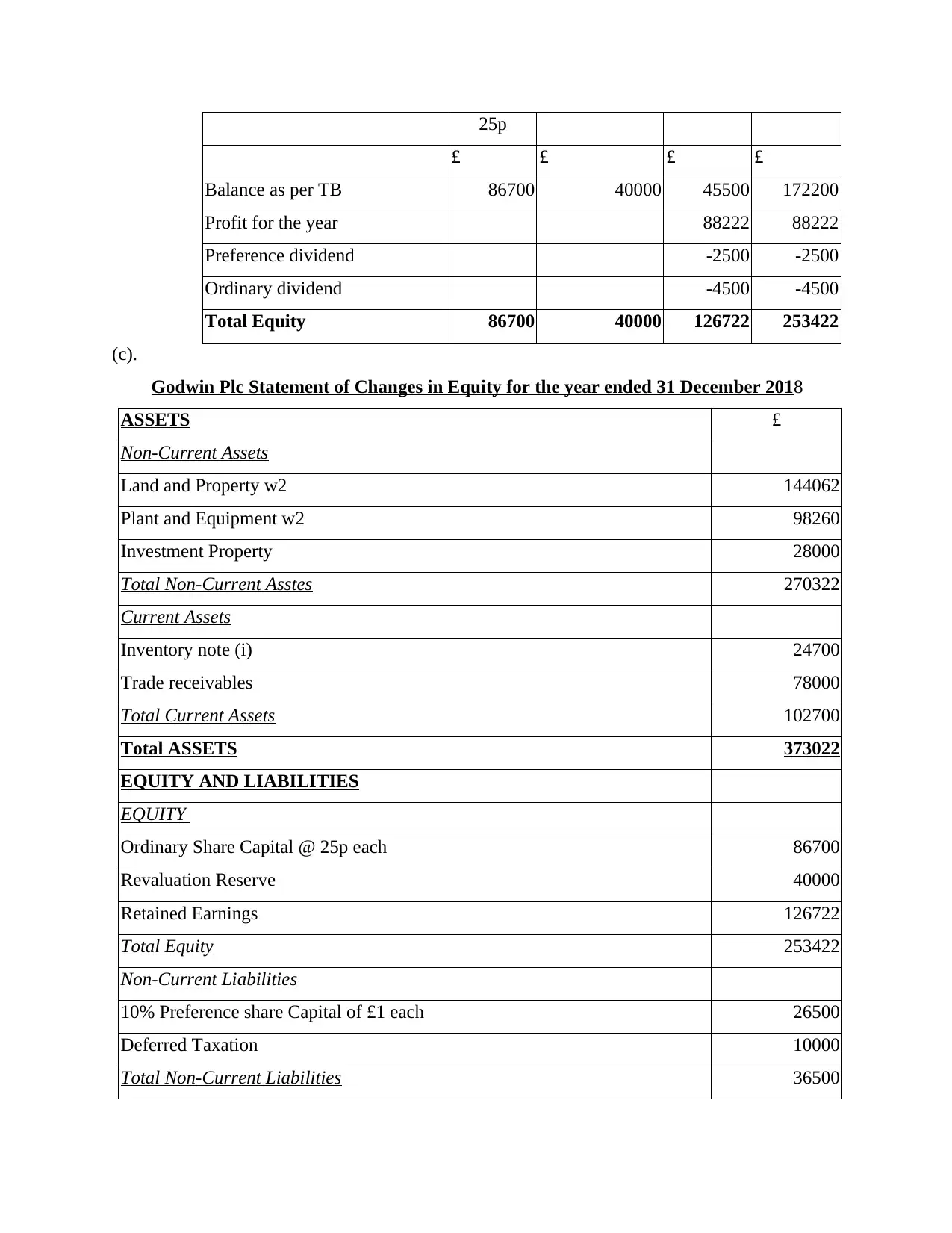
25p
£ £ £ £
Balance as per TB 86700 40000 45500 172200
Profit for the year 88222 88222
Preference dividend -2500 -2500
Ordinary dividend -4500 -4500
Total Equity 86700 40000 126722 253422
(c).
Godwin Plc Statement of Changes in Equity for the year ended 31 December 2018
ASSETS £
Non-Current Assets
Land and Property w2 144062
Plant and Equipment w2 98260
Investment Property 28000
Total Non-Current Asstes 270322
Current Assets
Inventory note (i) 24700
Trade receivables 78000
Total Current Assets 102700
Total ASSETS 373022
EQUITY AND LIABILITIES
EQUITY
Ordinary Share Capital @ 25p each 86700
Revaluation Reserve 40000
Retained Earnings 126722
Total Equity 253422
Non-Current Liabilities
10% Preference share Capital of £1 each 26500
Deferred Taxation 10000
Total Non-Current Liabilities 36500
£ £ £ £
Balance as per TB 86700 40000 45500 172200
Profit for the year 88222 88222
Preference dividend -2500 -2500
Ordinary dividend -4500 -4500
Total Equity 86700 40000 126722 253422
(c).
Godwin Plc Statement of Changes in Equity for the year ended 31 December 2018
ASSETS £
Non-Current Assets
Land and Property w2 144062
Plant and Equipment w2 98260
Investment Property 28000
Total Non-Current Asstes 270322
Current Assets
Inventory note (i) 24700
Trade receivables 78000
Total Current Assets 102700
Total ASSETS 373022
EQUITY AND LIABILITIES
EQUITY
Ordinary Share Capital @ 25p each 86700
Revaluation Reserve 40000
Retained Earnings 126722
Total Equity 253422
Non-Current Liabilities
10% Preference share Capital of £1 each 26500
Deferred Taxation 10000
Total Non-Current Liabilities 36500
⊘ This is a preview!⊘
Do you want full access?
Subscribe today to unlock all pages.

Trusted by 1+ million students worldwide
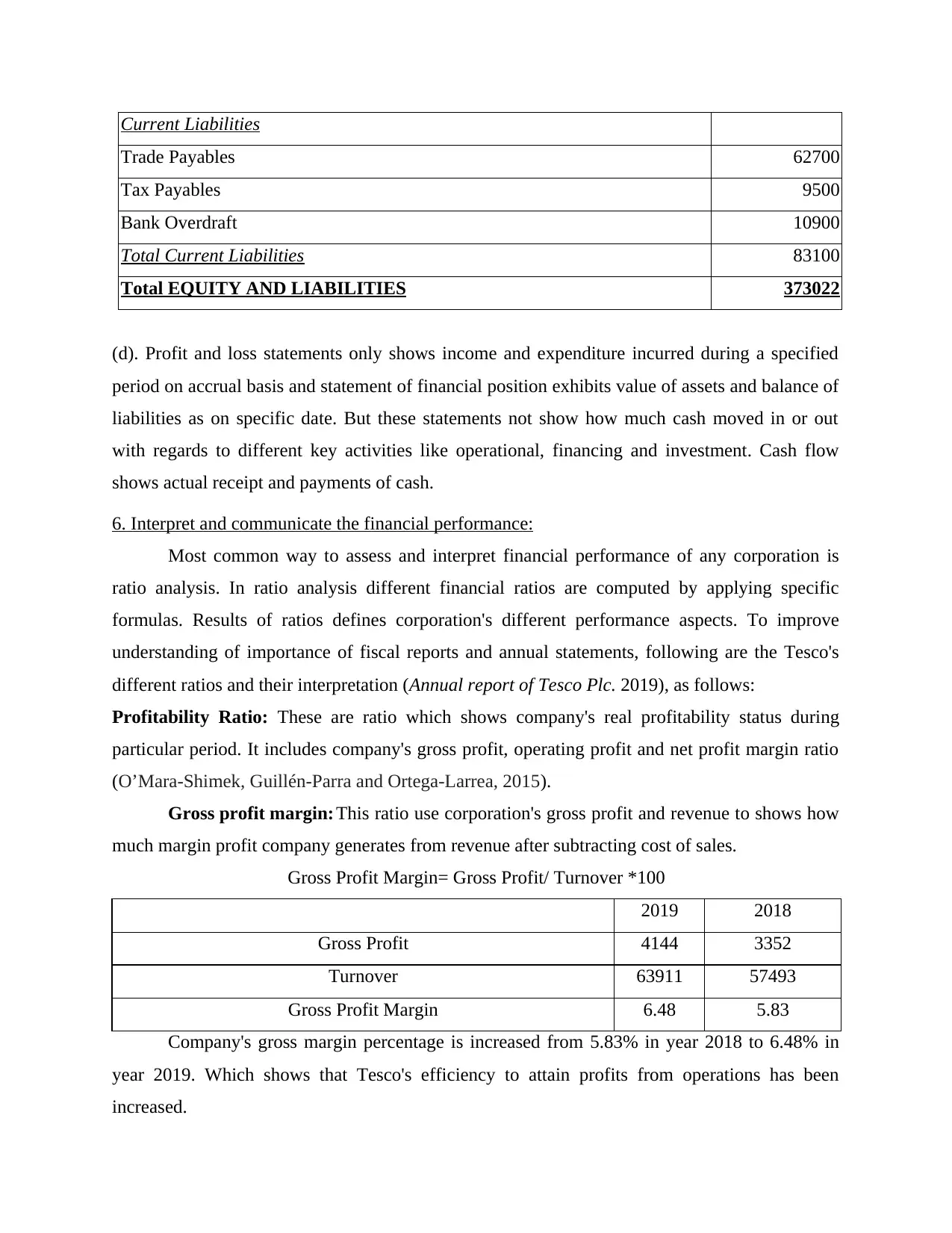
Current Liabilities
Trade Payables 62700
Tax Payables 9500
Bank Overdraft 10900
Total Current Liabilities 83100
Total EQUITY AND LIABILITIES 373022
(d). Profit and loss statements only shows income and expenditure incurred during a specified
period on accrual basis and statement of financial position exhibits value of assets and balance of
liabilities as on specific date. But these statements not show how much cash moved in or out
with regards to different key activities like operational, financing and investment. Cash flow
shows actual receipt and payments of cash.
6. Interpret and communicate the financial performance:
Most common way to assess and interpret financial performance of any corporation is
ratio analysis. In ratio analysis different financial ratios are computed by applying specific
formulas. Results of ratios defines corporation's different performance aspects. To improve
understanding of importance of fiscal reports and annual statements, following are the Tesco's
different ratios and their interpretation (Annual report of Tesco Plc. 2019), as follows:
Profitability Ratio: These are ratio which shows company's real profitability status during
particular period. It includes company's gross profit, operating profit and net profit margin ratio
(O’Mara-Shimek, Guillén-Parra and Ortega-Larrea, 2015).
Gross profit margin: This ratio use corporation's gross profit and revenue to shows how
much margin profit company generates from revenue after subtracting cost of sales.
Gross Profit Margin= Gross Profit/ Turnover *100
2019 2018
Gross Profit 4144 3352
Turnover 63911 57493
Gross Profit Margin 6.48 5.83
Company's gross margin percentage is increased from 5.83% in year 2018 to 6.48% in
year 2019. Which shows that Tesco's efficiency to attain profits from operations has been
increased.
Trade Payables 62700
Tax Payables 9500
Bank Overdraft 10900
Total Current Liabilities 83100
Total EQUITY AND LIABILITIES 373022
(d). Profit and loss statements only shows income and expenditure incurred during a specified
period on accrual basis and statement of financial position exhibits value of assets and balance of
liabilities as on specific date. But these statements not show how much cash moved in or out
with regards to different key activities like operational, financing and investment. Cash flow
shows actual receipt and payments of cash.
6. Interpret and communicate the financial performance:
Most common way to assess and interpret financial performance of any corporation is
ratio analysis. In ratio analysis different financial ratios are computed by applying specific
formulas. Results of ratios defines corporation's different performance aspects. To improve
understanding of importance of fiscal reports and annual statements, following are the Tesco's
different ratios and their interpretation (Annual report of Tesco Plc. 2019), as follows:
Profitability Ratio: These are ratio which shows company's real profitability status during
particular period. It includes company's gross profit, operating profit and net profit margin ratio
(O’Mara-Shimek, Guillén-Parra and Ortega-Larrea, 2015).
Gross profit margin: This ratio use corporation's gross profit and revenue to shows how
much margin profit company generates from revenue after subtracting cost of sales.
Gross Profit Margin= Gross Profit/ Turnover *100
2019 2018
Gross Profit 4144 3352
Turnover 63911 57493
Gross Profit Margin 6.48 5.83
Company's gross margin percentage is increased from 5.83% in year 2018 to 6.48% in
year 2019. Which shows that Tesco's efficiency to attain profits from operations has been
increased.
Paraphrase This Document
Need a fresh take? Get an instant paraphrase of this document with our AI Paraphraser
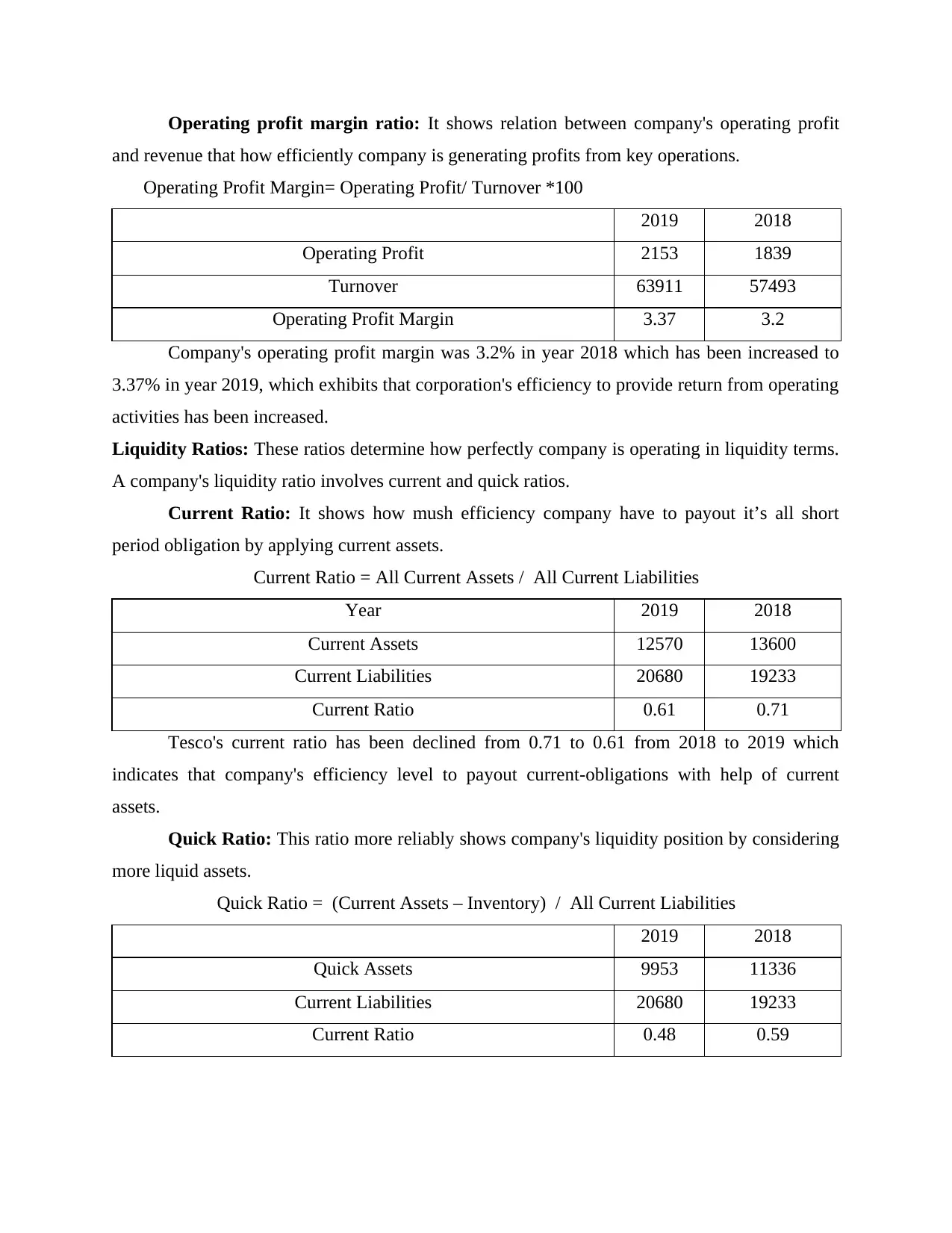
Operating profit margin ratio: It shows relation between company's operating profit
and revenue that how efficiently company is generating profits from key operations.
Operating Profit Margin= Operating Profit/ Turnover *100
2019 2018
Operating Profit 2153 1839
Turnover 63911 57493
Operating Profit Margin 3.37 3.2
Company's operating profit margin was 3.2% in year 2018 which has been increased to
3.37% in year 2019, which exhibits that corporation's efficiency to provide return from operating
activities has been increased.
Liquidity Ratios: These ratios determine how perfectly company is operating in liquidity terms.
A company's liquidity ratio involves current and quick ratios.
Current Ratio: It shows how mush efficiency company have to payout it’s all short
period obligation by applying current assets.
Current Ratio = All Current Assets / All Current Liabilities
Year 2019 2018
Current Assets 12570 13600
Current Liabilities 20680 19233
Current Ratio 0.61 0.71
Tesco's current ratio has been declined from 0.71 to 0.61 from 2018 to 2019 which
indicates that company's efficiency level to payout current-obligations with help of current
assets.
Quick Ratio: This ratio more reliably shows company's liquidity position by considering
more liquid assets.
Quick Ratio = (Current Assets – Inventory) / All Current Liabilities
2019 2018
Quick Assets 9953 11336
Current Liabilities 20680 19233
Current Ratio 0.48 0.59
and revenue that how efficiently company is generating profits from key operations.
Operating Profit Margin= Operating Profit/ Turnover *100
2019 2018
Operating Profit 2153 1839
Turnover 63911 57493
Operating Profit Margin 3.37 3.2
Company's operating profit margin was 3.2% in year 2018 which has been increased to
3.37% in year 2019, which exhibits that corporation's efficiency to provide return from operating
activities has been increased.
Liquidity Ratios: These ratios determine how perfectly company is operating in liquidity terms.
A company's liquidity ratio involves current and quick ratios.
Current Ratio: It shows how mush efficiency company have to payout it’s all short
period obligation by applying current assets.
Current Ratio = All Current Assets / All Current Liabilities
Year 2019 2018
Current Assets 12570 13600
Current Liabilities 20680 19233
Current Ratio 0.61 0.71
Tesco's current ratio has been declined from 0.71 to 0.61 from 2018 to 2019 which
indicates that company's efficiency level to payout current-obligations with help of current
assets.
Quick Ratio: This ratio more reliably shows company's liquidity position by considering
more liquid assets.
Quick Ratio = (Current Assets – Inventory) / All Current Liabilities
2019 2018
Quick Assets 9953 11336
Current Liabilities 20680 19233
Current Ratio 0.48 0.59
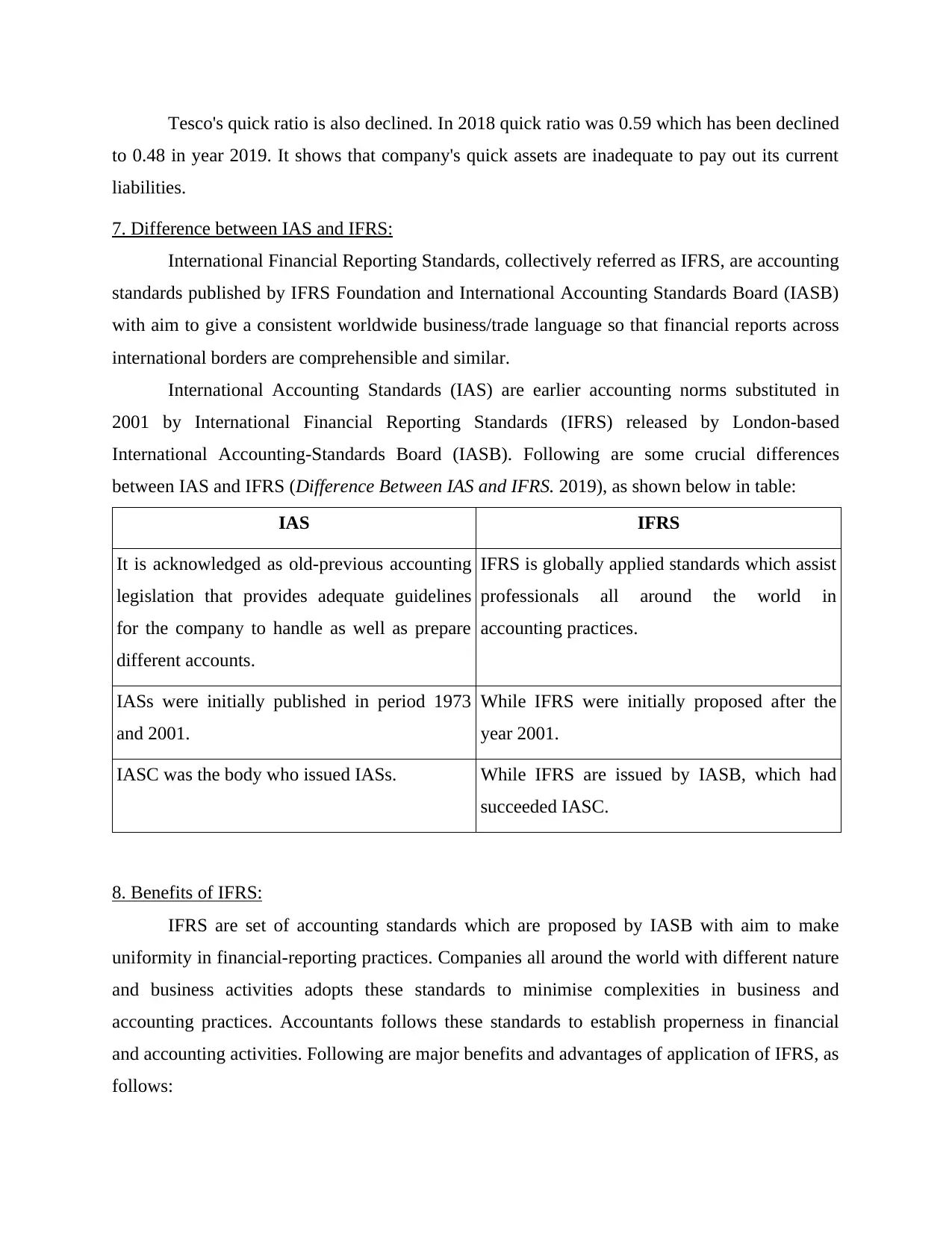
Tesco's quick ratio is also declined. In 2018 quick ratio was 0.59 which has been declined
to 0.48 in year 2019. It shows that company's quick assets are inadequate to pay out its current
liabilities.
7. Difference between IAS and IFRS:
International Financial Reporting Standards, collectively referred as IFRS, are accounting
standards published by IFRS Foundation and International Accounting Standards Board (IASB)
with aim to give a consistent worldwide business/trade language so that financial reports across
international borders are comprehensible and similar.
International Accounting Standards (IAS) are earlier accounting norms substituted in
2001 by International Financial Reporting Standards (IFRS) released by London-based
International Accounting-Standards Board (IASB). Following are some crucial differences
between IAS and IFRS (Difference Between IAS and IFRS. 2019), as shown below in table:
IAS IFRS
It is acknowledged as old-previous accounting
legislation that provides adequate guidelines
for the company to handle as well as prepare
different accounts.
IFRS is globally applied standards which assist
professionals all around the world in
accounting practices.
IASs were initially published in period 1973
and 2001.
While IFRS were initially proposed after the
year 2001.
IASC was the body who issued IASs. While IFRS are issued by IASB, which had
succeeded IASC.
8. Benefits of IFRS:
IFRS are set of accounting standards which are proposed by IASB with aim to make
uniformity in financial-reporting practices. Companies all around the world with different nature
and business activities adopts these standards to minimise complexities in business and
accounting practices. Accountants follows these standards to establish properness in financial
and accounting activities. Following are major benefits and advantages of application of IFRS, as
follows:
to 0.48 in year 2019. It shows that company's quick assets are inadequate to pay out its current
liabilities.
7. Difference between IAS and IFRS:
International Financial Reporting Standards, collectively referred as IFRS, are accounting
standards published by IFRS Foundation and International Accounting Standards Board (IASB)
with aim to give a consistent worldwide business/trade language so that financial reports across
international borders are comprehensible and similar.
International Accounting Standards (IAS) are earlier accounting norms substituted in
2001 by International Financial Reporting Standards (IFRS) released by London-based
International Accounting-Standards Board (IASB). Following are some crucial differences
between IAS and IFRS (Difference Between IAS and IFRS. 2019), as shown below in table:
IAS IFRS
It is acknowledged as old-previous accounting
legislation that provides adequate guidelines
for the company to handle as well as prepare
different accounts.
IFRS is globally applied standards which assist
professionals all around the world in
accounting practices.
IASs were initially published in period 1973
and 2001.
While IFRS were initially proposed after the
year 2001.
IASC was the body who issued IASs. While IFRS are issued by IASB, which had
succeeded IASC.
8. Benefits of IFRS:
IFRS are set of accounting standards which are proposed by IASB with aim to make
uniformity in financial-reporting practices. Companies all around the world with different nature
and business activities adopts these standards to minimise complexities in business and
accounting practices. Accountants follows these standards to establish properness in financial
and accounting activities. Following are major benefits and advantages of application of IFRS, as
follows:
⊘ This is a preview!⊘
Do you want full access?
Subscribe today to unlock all pages.

Trusted by 1+ million students worldwide
1 out of 16
Related Documents
Your All-in-One AI-Powered Toolkit for Academic Success.
+13062052269
info@desklib.com
Available 24*7 on WhatsApp / Email
![[object Object]](/_next/static/media/star-bottom.7253800d.svg)
Unlock your academic potential
Copyright © 2020–2025 A2Z Services. All Rights Reserved. Developed and managed by ZUCOL.





